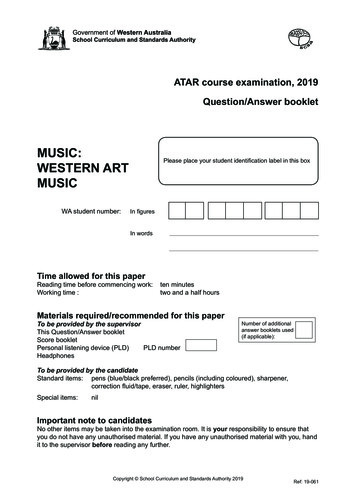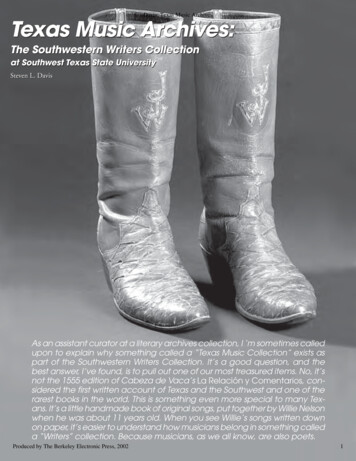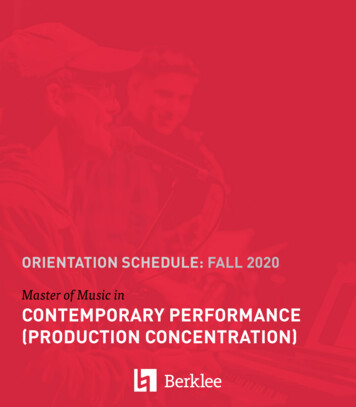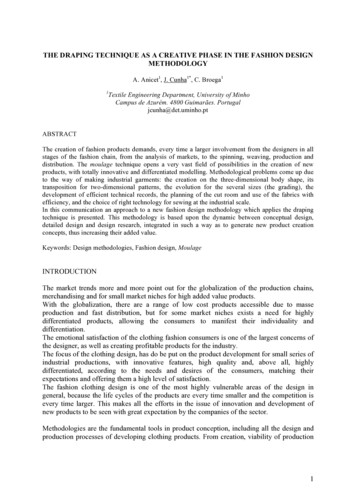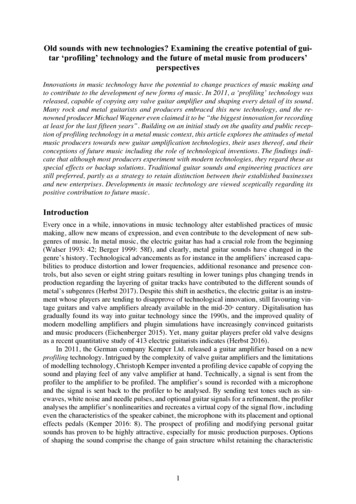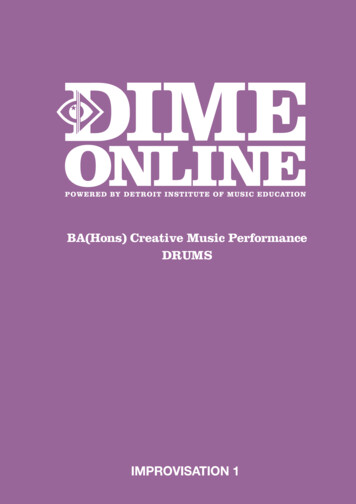
Transcription
BA(Hons) Creative Music PerformanceDRUMSIMPROVISATION 1
IMPROVISATION 1Duration: 15 weeks20 CREDITSCost: 700Recommended Ability Level: Equivalent to Grade 7 playing ability &Grade 5 music theory knowledgeYou now have the opportunity to experience some of the core material featured in our BA(Hons) degreecourses. This will give you the chance to experience what it’s like to study online through our virtuallearning environment, Canvas.Standalone Modules are exactly the same content as our BA(Hons) degree courses and are each worth20 credits. If you wish to progress onto the full degree programme then these credits can transfer.You will be able to experience studying with DIME ONLINE in cost effective bite-size chunks, with expertinstruction focusing on specialist areas.The Standalone Module offer includes: Each module worth 20 Credits at Level 4 Credits that are transferable onto the full BA(Hons) degree programme Being part of DIME ONLINE’s learning community through Canvas, our Virtual Learning Environment Identical content to the BA(Hons) degree Detailed material for professional development Expert one-to-one instructor feedbackThe aim of this module is to enable you to: Develop core improvisational skills on your instrument Understand core melodic, harmonic and rhythmic vocabulary and related improvisation conventionsthat inform individual decision-making during improvisation performance contexts Apply improvisation conventions and vocabulary creatively in the context ofgenre-specific repertoire3
Module DescriptionYou will be spending a considerable amount of time developing core skills on your instrument, and theapplication of these skills comes in the improvisation modules. It’s here that you will go beyond thepractice of basic exercises and develop your ear to ensure that you can place patterns, rudiments, fillsand ostinatos into a musical context.We will provide you with a number of stylistic studies designed to challenge you to creat musicallyappropriate parts and improvised solos. Additionally, we will investigate how you can gain the authorityof a professional through your sound, timing, and dynamic balance. You will be referencing the workof some of the world’s iconic drummers as you learn the art of making music from the tool kit of yourtechnical skills.On completion of this Module you shouldbe able to:Assessment Criteria. To achieve the learningoutcome you must demonstrate the ability to:Demonstrate an understanding of core improvisationskills and devices specific to the discipline in the contextof performance. (Creative Music Performance 1)Present and perform a range of specialised isolatedimprovisation exercises.Display elements of creativity and expression duringimprovisation. (Creative Music Performance 3)Combine melodic, harmonic and rhythmicallyappropriate language during genre-specificimprovisation.Demonstrate an awareness of the broader musicalcontext in which improvisation concepts may beapplied. (Creative Music Performance 4)Demonstrate the ability to select or omit appropriateimprovisational devices in the context of genrespecific improvisation-based performance.Skills DevelopmentKnowledge and Understanding You will gain an understanding of the vocabulary and conventions used in improvisation through themodule content. You will explore foundational core concepts that are critical to the study of improvisation.Intellectual Skills You will have an opportunity to develop and apply relevant cognitive and analytical skills when engagingwith the theory and philosophy of improvisation.Practical Skills You will develop the ability to apply foundational improvisation concepts and theory to your instrument. You will develop your skills with regards to identifying and applying improvisation language and theoryin context, through engagement with lead sheets, transcriptions, scores and recordings.Transferable Skills You will have the opportunity to develop a creative and integrative approach to study, in whichintellectual study and practical application are weighted equally.4
Assessment StrategySummative assessment (Submission of filmed performance)You will be asked to submit an 8-10 minute filmed performance demonstrating: A range of isolated improvisation exercises that highlight the core concepts underpinning the module. Application of improvisational concepts in the context of a pre-agreed genre-specific performance.The ‘pre-agreed’ performance will allow students to integrate improvisation vocabulary in a contextuallyrelevant manner. The repertoire will be agreed with your tutor during the trimester.Summative assessment will occur at the end of Trimester 1, with formative assessment taking place atthe mid-way point of the module (week 8). Feedback from weekly improvisation tasks will enable you toadjust and improve aspects of your playing on a frequent and regular basis.The following aspects of performance will be taken into consideration: Timing Tuning Accuracy of execution Sound and tonal production Fluency of phrasing Consistency of delivery Appropriateness of decision-making in the context of performance Creative intention and use of concepts and vocabulary5
Scheme of WorkImprovisation 1Week1DescriptionIMPROVISATION - COURSE INTRODUCTIONWhat is improvisationImprovised rock fillsRock fills with extended lengthsLearn to play two bars of grooves and two bars of fillsListen to Cozy Powel’s Dance With The Devil soloTaskYour most important task for this week is simply to let your imagination freely create someimprovised drum fills. Do these in increasing lengths – from one up to four bars per theexercises – while challenging yourself to break out of your comfort zone and come up withfresh fills, not merely repeat what you already know. Other than this, listen to and analyseDance With The Devil.Additional StudyLed Zeppelin (1969) – Led Zeppelin II: Moby Dick (CD) Drummer: Bonham, JohnCream (1967) – Fresh Cream: Toad (CD) Drummer: Baker, Ginger2IMPROVISING WITH SINGLES, DOUBLES AND BASIC RUDIMENTSImprovising with one handed singles around the drumsImprovise with Single Stroke Roll around the drums Start with eight notes Move up to tripletsDouble Stroke Roll Improvisation exercisesIdeas with split doublesLearn the Flams Accents Study the different stick heights and stick positions Analyse the Tap and the Full Stroke Learn the right handed and the left handed FlamsMove the left handed Flams Accents around the tomsAlternating Flam Taps in different groupingsSingle Paradiddle variations on the toms and snareImprovise with the four variations of Single ParadiddleReboundUsing the necessary amount of rebound6
2TaskPay close attention to the accuracy of your singles and doubles as these are the mostimportant and most often used rudiments. Practice technique in front of a mirror.The singles and doubles are the basic elements/components of almost all of the future rudiments, therefore it’s extremely important to master them and play them with ease, comfort, confidence and speed. As always, practice and perfect what you are learning. Recordand critique your motions, then correct and carry on until you are comfortable enough tore-record your performance and post it to the Canvas.Additional Study:Cobham, Billy (1973) SpectrumCobham, Billy (1975) Shabazzwww.vicfirth.com3IMPROVISING WITH BASIC RUDIMENTS IILearn the Flams Accents Study the different stick heights and stick positions Analyse the Tap and the Full Stroke Learn the right handed and the left handed FlamsSingle Paradiddle variations on the toms and snareImprovise with the four variations of Single ParadiddleTaskPractice these as fills is to work out different sticking variations on a practice pad or snaredrum, then apply them around your kit. Also, the phrasing of these rudiments is the keyfactor to ensuring they good sound.Additional Studywww.vicfirth.com4SINGLE PARADIDDLE GROOVES AND MOELLER MOTIONSLearn the basic Single Paradiddle GrooveOrchestrate your grooveIndependence exercisesFurther grooves with the Inverted ParadiddleTaskThe single paradiddle variations are absolutely essential rudiments. They can be playedas rudiments on a snare, as grooves on a kit and they are very useful for moving from onedrum to the other, as a double stroke frees up your other hand to lead to another drum.But our focus right now is paradiddle grooves. It is important to play these with distinctlybig dynamics, where the singles and double are of different volumes. And play with tighttiming. The Moeller Motions will help you with your phrasing, but always mind your dynamics. Record yourself and listen back, then upload your recordings to the Canvas.Additional StudyChambers, Dennis – In the Pocket (DVD) Hudson MusicHakim, Omar – Express Yourself/ Let It Flow (DVD) Alfred Publ.Tower of Power (1973) – Tower of Power (CD) Drummer: Garibaldi, David7
5MOELLER OSTINATOS IN GROOVES AND FILLSThe ‘one stroke-one bounce principle’ on hi-hatThe one stroke two bounces principleThe one stroke-three bounces 16th note grooveAccented Single Stroke Rolls with Moeller TechniqueTaskAlways strive to play and sound musical when you apply any techniques, whether practicing or within a musical context.This week’s material is a classic example of how to turn technique into music and use itfor your own benefit. Once you have the right technique, you’ll need much less effort toexecute these grooves with ease. This will also help your endurance and timekeeping.Start with the one stroke-one bounce principle, then gradually build up your speed. Clarityand note quality are extremely important, so make sure you don’t slip into playing swungsixteenth notes.Additional StudyMayer, Jojo (2007) - Secret Weapons Of The Modern Drummer (Hudson Music DVD)www.vicfirth.comKatche, Manu – Zildjian commercial video and other clips on YouTubeHakim, Omar – Express Yourself (DVD) Alfred6SERIOUS MOTIONS - MOVING AROUND THE KIT IMPROVISATIONTriplets around the toms in different directionsPlaying the first notes of the triplets on the crashesIncorporating the double bass drum pedal in faster temposMoving around the toms with tripletsDifferent wrist turns and backhand motionsTaskThis week, we’ve mainly experimented with triplets around the kit. They’re a great way tomove from sound to sound, because the odd number of notes in each – three – meansyour leading hand will constantly change. Make sure you’re equally comfortable with thesame motions, whether starting with your right or left hand. This will take time and patience, so practice slowly and accurately.Record yourself while playing your triplets between the crashes and the snare. Make sureyou’re doing the same motions with both hands. And try to avoid unnecessary motionfrom the shoulders and upper body.Additional StudyDornyei,Gabor (2014) - Moving Around The Kit (DrumChannel You-Tube)Chambers, Dennis (1992) – Serious Moves (DVD) Warner Bros Publ.8
7BALANCE CO-ORDINATION AND ENDURANCE ON FEETFinding your balance on the drum throneSingle strokes co-ordination exercises between the hands and the feetThe ‘Vinnie Colaiuta cross exercise’Straight sixteenth note singles on the double bass pedalFurther co-ordination exercisesTaskAdvanced foot technique is extremely important in modern drum set playing.Not only because of the fills and variations, but in order to play the downbeats in yourgeneral grooves perfectly in time. Make sure you don’t rush these exercises. These examples are not necessarily for speed, but much rather for perfect control over your limbs. Tryto play four hundred repeats from each stroke before you move on to the next exercise.Always practice to metronome, record yourself and upload it to Canvas.Additional StudyLang, Thomas (2004) - Creative Control (Hudson Music DVD)8Formative AssessmentTaskYour tutor will provide you with a task that demonstrates your learning in the module todate. You will need to upload the task to Submit My Assignment for feedback.9IMPROVISATION WITH DOUBLES ON THE FOOTDisplacing the bass drum doubles in a 4/4 grooveDouble strokes bass drum patterns over 16th note hi-hat patternsCombinations of single and double strokes on the foot‘Three over four’ polirhythmic pattern on the bass drumFills and grooves combined with doubles on footTaskThis week you’ve experienced plenty of variations for the displacement of double strokeson the bass drum. It is very important to play these with ease and confidence, so concentrate first on your technique and fluency. Once you’re comfortable with those, youshould find it much easier to displace the notes. Again, it is very important to play witha relaxed and confident feel, and that your sound be tonally rich and balanced. When itcomes to performing on stage or recording these in a studio, you definitely don’t wantthem to sound like exercises. Your bass drum notes must be perfectly in time to createreal grooves.Additional StudyWeckl, Dave (1991) - Back to the Basics (Hudson Music DVD)9
10PARADIDDLE IMPROVISATIONThe orchestration of single and double ParadiddlesThe combination of ‘Inverted Paradiddle’ and Double Paradiddle with four accentsThe Paradiddle PyramidThe Paradiddle-DiddleTaskAfter this week’s extensive paradiddle workout in the Technical Development and Improvisation classes, you’ve studied all you need to play all the different paradiddle variationsand accents. Practise each of these exercises at a slow tempo for a minimum of 15-20minutes daily. Once completely comfortable playing one, move to the next or increase thespeed of the one you’ve learnt. Before you try these behind a drum kit, ensure you’re using the correct wrist and arm motions by practising on your pad in front of a mirror. Whenyou’re playing them on the kit as melodic orchestrations, make sure your arm motions arefluent and movement is relaxed and stress-free as you move around your drums.Avoid ‘playing into’ the drums by using the maximum available rebound.Additional StudyMore
www.vicfirth.com 3 IMPROVISING WITH BASIC RUDIMENTS II Learn the Flams Accents Study the different stick heights and stick positions Analyse the Tap and the Full Stroke Learn the right handed and the left handed Flams Single Paradiddle variations on the toms and snare Improvise with the four variations of Single Paradiddle Task Practice these as fills is to work out different .




